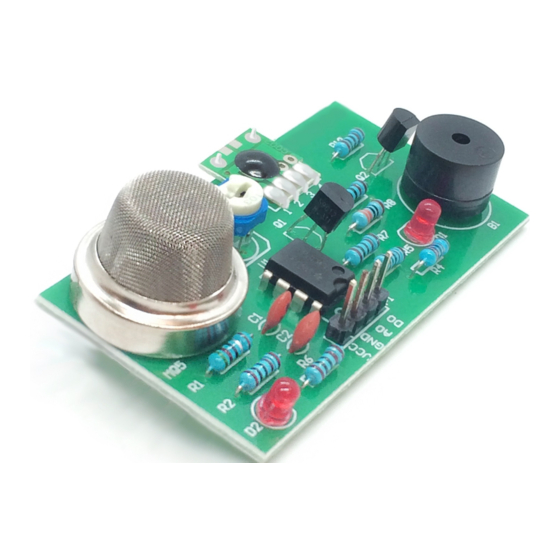Summary of Contents for Abra AK-325
- Page 1 Methane, Butane and LPG Detector D.I.Y Kit for detecting methane (CH ), butane (C ) and LPG in household or workplace environment using the MQ2 AK-325 Part Number: Level: Intermediate...
-
Page 2: Specification
Description: This kit contains the required components to build yourself a petroleum gas detector. This module is based on a LM393 I.C. and a MQ2 sensor. While being a simple soldering project for beginners, this kit can be used in a variety of small personal, educational or enterprise applications such as: Methane, Butane and LPG Detector for Microcontrollers (Analog/Digital) Methane, Butane and LPG Detector for Arduino (Analog/Digital) -
Page 3: Bill Of Materials
Bill of Materials: This package includes 23 pieces which are listed below along with their labels and quantity. Quantity Component Label Value / Type / Label 5.1Ω / (Green, Brown, Black, Silver) R2, R5, R6, R7, R9, R10 1KΩ / (Brown, Black, Black, Brown) 10KΩ... - Page 4 Assembly: 1) In order to assemble the module, you need the following tools: *It is recommended to have some isopropyl alcohol and a fine soldering brush handy to clean off the excess flux on the circuit board when the soldering is done. *ATTENTION* DO NOT USE RUBBING ALCOHOL, IT WILL DAMAGE THE COMPONENTS.
- Page 5 b) The soldering iron temperature depends on the type of solder used. If you are using a typical 60/40 lead solder, depending on the thickness the temperature should be set anywhere between 370 to 500 °F (187 to 260 °C). If you are using a lead-free solder, increase above temperatures by 40 to 70 °F (5 to 20 °C).
- Page 6 To begin the assembly process, insert the resistors as shown in the photo. Pay attention to the color coding of the resistors as indicated in the “Bill of Materials” section on page 3. All soldering will be done on the backside of the board. You may proceed to solder the ceramic capacitors and the LEDs in place by following the...
- Page 7 Insert the transistor, the potentiometer and the IC as shown in the picture. Ensure the transistor’s flat side matches the outline of the silkscreen. Ensure the notch of the IC aligns with the markings on the board, also known as the silkscreen.
- Page 8 On the provided sound chip card, solder the remaining resistor (R11) in the kit on the two through-hole pads as shown. This secondary PCB has an integrated sound chip that controls the buzzer when it goes off. You have two options to solder this component.
- Page 9 Implementation: You have three methods you can use this module. The first method is to use this device as a standalone module where, when gas is detected in the MQ2 the buzzer will make a noise and D1 will light up to inform you that Methane, Butane or LPG has been detected.



Need help?
Do you have a question about the AK-325 and is the answer not in the manual?
Questions and answers